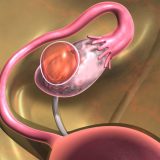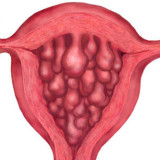In recent years, more and more patients with cancer approach doctors. Oncology is becoming the most common misfortune of the XXI century. The tumor has a lot of species. It is very important to detect the inflammation in time, so that the disease is not turn in a more serious form. One variety of the tumors with a positive trend of treatment is a dermoid cyst.
What is a dermoid cyst
Such a disease, such a cyst, is a pathologic disorder in the body when cavities having walls form. Development of the tumor occurs in various organs and for different reasons. It all benign with the cavity formation from germ layers, getting bigger it contains particles of skin, teeth, hair follicles, nails, sebaceous glands and pigment cells.
Teratoma often has a size of 5 to 7 cm. But there are cases when it can reach more than 15 cm in diameter.In most cases, it has a rounded shape and a leg, using which to attachment to the main part. When growing the teratoma elongates.
The development of dermoid cyst in the ovaries
The most common type of dermoid cyst is the one in women ovaries. At the same time there is no specific age group or prone to this disease. It can affect a completely different organs. But the most common is ovary. In case of violation of the ovaries, they are retained embryonic beginnings, which become the basis for filling the cyst cavity.
What causes a dermoid cyst in the ovaries
Medicine still can not give a precise answer to the question why a dermoid cyst develops in ovary. The causes of the tumor formation presumably have a basis in the natural processes of the reproductive organs. If failure occurs, the cyst develop. Reasons for the failures, in their turn, are various. When a woman’s body carries stress, it leads to hormonal failure. The failure can also be a result of menopause, pregnancy or puberty during bad health condition of the patient. Another risks are injuries. Then the growing of germ layers is activated, and the tumors begins to develop.
Dermoid cystic formation in the left ovary
In medical practice, it found that the teratoma occurs in the right ovary with the highest frequency. This is due to the fact that parts of organs vary considerably between them, and the right ovary carries the main functional activity. It is much better supplied with blood and usually ovulates. For this reason that a hormonal imbalance is reflected slightly on the left side. In this regard, a dermoid cyst of the left ovary is a rare case.
As a rule, the volume reaches its maximum 4 – 6 cm. However, despite this, after the diagnosis of the disease must be the removal of the affected organ. The complexity of this form of the disease is the lack of any symptoms. Therefore, if the patient does not go to the gynecologist, the cyst can exist in her body for years. The consequence of such a tumor, dermoid cyst, is a problem with the ability to become pregnant.
Dermoid cyst of the head
A dermoid cyst in a head is a benign outgrowth. This form of the disease has no specific location. Development is possible on the eyelids, lips, eyes, nose, neck, nasolabial folds, ears, and in the nasopharynx, oral cavity and on the scalp.
Just like other types of dermoid tumors, this inflammation develops with no symptoms. However, when a cyst reaches a larger size, it becomes visible on the skin. Treatment is carried out only by surgery. Removal of the tumor is made as soon as possible after detection. Exceptions are children under five, because the operation is done under general anaesthesia. If the cyst does not threaten the life of the child, the doctor is waiting to achieve the desired age, and then carries out the operation.













